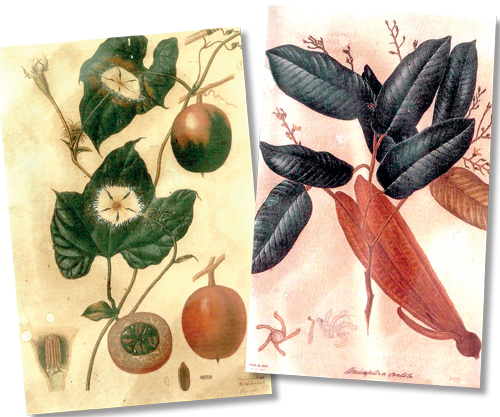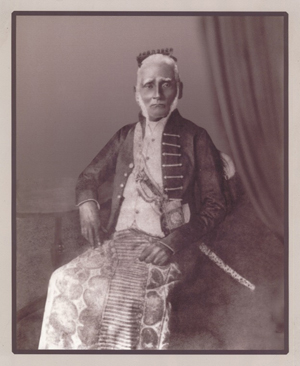A family famed for botanical illustration now forgotten

Illustrations by James de Alwis (left) and Charles de Alwis (above) -- Singapore 1900
By strange twists of fate, personalities in the arts and sciences who have made significant contributions to their fields often remain forgotten by the public and unacknowledged by those in officialdom. The number of artists and scientists whose portraits are represented on a postage stamp or on currency notes is marginal; neither are they honoured by having a street named after them.
One such lineage is that of Harmanis de Alwis Seniviratne, the patriarch whose descendants for over two centuries dominated the field of Natural History illustration. Not only did they document and draw the flora of Sri Lanka but also that of neighbouring South India, and Singapore, Malaysia as well parts of Indonesia.
Much has been documented of Haramanis’s work, but little known here are James and Charles de Alwis, whose saga began in 1889 when Henry Nicholas Ridley (1855-1956), Director of the Botanical Garden, Singapore, asked his counterpart at the Royal Botanical Gardens at Peradeniya for his Draftsmen to be loaned to work on illustrations of Malayan flora.
It is believed that James de Alwis and Charles de Alwis were selected and sent to delineate the flora of Singapore, neighbouring Malaysia, as well as Indonesia.
The exact relationship between James and Charles and theirs with Harmanis has not been established.
Harmanis de Alwis Seniviratne was appointed native clerk or writer when the Botanic Garden project was still at its fledgling stage under Alexander Moon, the Resident Superintendent in 1817. Moon had taken up the challenge of moving the garden from Slave Island, Colombo (where the first Botanic Gardens under the British was founded by his predecessor William Kerr) to Kalutara. Recruited as a draftsman to the Botanical Gardens, in 1818, when in his twenties, Harmanis accompanied Moon when the Botanic Gardens was translocated in 1821 to Peradeniya and by 1825, was appointed the Chief Draftsman for the Gardens.
When in 1830, the renowned botanist of Indian flora Robert Wright (1796-1872), Superintendent of the Botanic Gardens at Chennai (Madras), Tamil Nadu visited Sri Lanka, he was so impressed with Harmanis’s work, he persuaded him to travel to Chennai, where he was trained under him for three months in floral dissection and worked on the plates of ‘Icones Planatarum India Orientalism’.

Patriarch of the family: Harmanis de Alwis Seniviratne
While under Wright’s guidance, Harmanis underwent further training to illustrate these dissected specimens with the aid of a microscope. Within the short period he was in Chennai, he documented and illustrated a wide range of publications on South Indian plant species.
In 1826, Harmanis’ salary was a paltry 12 Pounds per annum but he held the vital post of Chief Draftsman for 36 years. By the time he retired at 70, Harmanis had illustrated over 2000 species of the flora of Sri Lanka.
Harmanis accompanied several Superintendents of the RBG Peradeniya including George Gardiner (1812-1849) and George Henry Thwaites (1812-1882) on field trips to collect and identify new species. His skill in identifying and documenting them was unparalleled. He enriched the plant collection of the Herbarium at Peradeniya.
In 1859, R. Lindley named a tiny orchid ‘Taeneophyllum alwisi’ after him but unfortunately this is not recognised as a species by recent taxonomists.
In acknowledgement of his lifetime of work and contribution to the RBG, Harmanis was showered with various titles; he was made Muhandiram in 1831, and later Mudliyar in 1854. He died on June 10, 1894 aged 101.
Harmanis was succeeded by his two sons, William and George. William was first appointed as an assistant to this department in 1854 and later promoted to Chief Draftsman of the Herbarium.
By the time of his retirement, William had successfully documented as many as 1000 species – particularly family of fungi (for the study of mycology).
William did not confine himself only to botanical subjects. On the advice of Henry Thwaites and with the encouragement of Governor Sir William Gregory, he set up a project that he initially funded privately. In 1874, William commenced the illustration of the Lepidoptera fauna (butterflies and moth species) and completed the portfolio in 1878, that culminated in the publication of a five-volume tome authored by Frederick Moore in 1880-1890.
By 1902 William’s son Alfred (Harmanis’s grandson) took on the post of Head Draftsman.
Another of his sons Gregory de Alwis made special duplicate set of copies of these for Governor Gregory, on a private basis.
At least three or more sons (and grandsons) – Harmanis descendants were also employed by the Department of Agriculture which then managed the affairs of the Royal Botanic Gardens.
In 1921, when the Centenary volume of the Royal Botanic Gardens, Peradeniya was published, it recorded that four of William’s sons were employed at Peradeniya. Listed are Edwin de Alwis, Edmund de Alwis, Alfred de Alwis and A.G. de Alwis. Little is known of George’s descendants.
Remarkably in the next few decades up until 1950, various close relatives of the de Alwis Seniviratne family were selected to illustrate publications by the Department of Agriculture.
In 1951, the illustrations for the ‘Manual of the Weeds of Major Crops of Ceylon’ were selected from the plates from the Herbarium collection by A. George de Alwis.
In 1956, S.D.J.E. Senaratne, author of ‘Grasses of Ceylon’ acknowledged the work of the illustrator – ‘Mr. A.G. Alwis, the artist, formerly draftsman of the Systematic Botanist, Peradeniya’.
Going back to James and Charles de Alwis, some scanty data emerged that Charles left the Singapore Gardens and took up to photography. But very little else is known of these two talented artists.
According to the Annual Report of the Singapore Botanical Garden (SBG) of 1890, James de Alwis was the first of the two de Alwises to be appointed as member of the drafting staff of the SBG. The majority of their original drawings were executed at the behest of the Director of the Botanical Gardens, Singapore and the Straits Settlement Dr. Henry Nicholas Ridley (1855-1956).
In 1890, Dr Ridley in his department’s Annual Report noted;
In March Mr. De Alwis arrived from Ceylon and was employed out of the vote of the publication of the Malay Flora in making drawings of the rarer and more interesting plants of the Peninsula executed seventy highly finished and accurate coloured drawings.
Although not clarified by name, it was most likely to have been James de Alwis.
By the end of the year James had produced a small part of the 2000 drawings of flora which represented not only the flora of Singapore but also the Malay Peninsula and a part of Indonesia as well.
Almost a decade later, the SBG Annual Report states;
The Artist Chaudry was employed in making drawings of interesting plants till July when he was attacked by a brain disease and became insane. He was sent an asylum and was eventually returned to Calcutta.
Charles de Alwis was transferred from the Public Works Department where he had been employed as a photographer. And commenced work here on November.
Vote — S$700.00
Salary of Artist — S$450.00.
The fine quality illustrated plates produced by James de Alwis and Charles de Alwis during their tenure of draftsmen at the SBG between 1890-1910 was highlighted in Japan when in September 2002, works from the Singapore Herbarium went on display in Japan at the Kochi Prefecture Botanical Garden. The exhibition “Welcome to the Flora Gardens of Asia” which continued till February 2003 was attended by thousands of visitors. Interestingly, the majority of the original illustrations for the detailed catalogue was the work of Charles de Alwis and James de Alwis.
It was Dr. Ruth Kew who in 1990 on my visit to the SBG drew my attention to the work of James and Charles de Alwis which were in the archival collection.
In 2010, when I met Dr Christina Soh, Curator of the Singapore Garden’s Herbarium at her office, she informed me that Charles de Alwis work is represented by 212 drawings and James de Alwis by 18. This was clearly not their total output. Many of the plates that they worked on were lent to the Kew Gardens, London and only a handful were returned. Others were lost in the post!
The de Alwis family’s contribution to scientific documentation is unparalleled in the history of natural history drawings of both museum specimens as well as those in the wild.
Searching for an ideal partner? Find your soul mate on Hitad.lk, Sri Lanka's favourite marriage proposals page. With Hitad.lk matrimonial advertisements you have access to thousands of ads from potential suitors who are looking for someone just like you.


